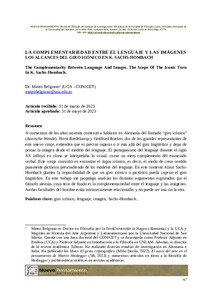Por favor, use este identificador para citar o enlazar este ítem:
https://repositorio.uca.edu.ar/handle/123456789/17215| Título: | La complementariedad entre el lenguaje y las imágenes : los alcances del giro icónico en K. Sachs-Hombach The complementarity between language and images : the scope of the iconic turn in K. Sachs-Hombach |
Autor: | Belgrano, Mateo | Palabras clave: | LENGUAJE; IMAGEN; ICONOGRAFIA; LINGÜISTICA; Sachs-Hombach, Klaus | Fecha de publicación: | 2023 | Editorial: | Universidad del Salvador. Facultad de Filosofía, Letras y Estudios Orientales. Instituto de Investigaciones Filosóficas | Cita: | Belgrano, M. La complementariedad entre el lenguaje y las imágenes : los alcances del giro icónico en K. Sachs-Hombach [en línea]. Nuevo Pensamiento. 2023. 8(21). Disponible en: https://repositorio.uca.edu.ar/handle/123456789/17215 | Resumen: | Resumen: A comienzos de los años noventa comenzó a hablarse en Alemania del llamado “giro icónico”
(ikonische Wende). Horst Bredekamp y Gottfried Boehm, dos de los grandes representantes de
este nuevo viraje, entienden que es preciso superar o ir más allá del giro lingüístico y dejar de
pensar la imagen desde el modelo del lenguaje. El protagonismo del lenguaje durante el siglo
XX influyó en cómo se interpretaba lo visual: como un mero complemento del enunciado
verbal. Este viraje consistió en encontrar el logos icónico, es decir, el modo de crear sentido
puramente pictórico prescindiendo de los modelos del lenguaje. En este contexto Klaus Sachs-
Hombach plantea la imposibilidad de que un giro icónico o pictórico pueda superar el giro
lingüístico. En este trabajo me propongo analizar los distintos argumentos esgrimidos por el
filósofo alemán, cuya tesis de fondo es la complementariedad entre el lenguaje y las imágenes.
Ambas facultades del hombre están intrínsecamente relacionadas y no puede ser una sin la otra. Abstract: At the beginning of the 1990s, the so-called “iconic turn” (ikonische Wende) began to be discussed in Germany. Horst Bredekamp and Gottfried Boehm, two of the great representatives of this new turn, understand that it is necessary to go beyond the linguistic turn and stop thinking about the image from the model of language. The prominence of language during the 20th century influenced how the visual was interpreted: as a mere complement to the verbal statement. This shift consisted in finding the iconic logos, that is, the way to create purely pictorial meaning without the models of language. In this context, Klaus Sachs-Hombach argues that it is impossible for an iconic or pictorial turn to overcome the linguistic turn. In this paper I intend to analyse the various arguments put forward by the German philosopher, whose basic thesis is the complementarity between language and images. Both human faculties are intrinsically related and cannot be one without the other. |
URI: | https://repositorio.uca.edu.ar/handle/123456789/17215 | ISSN: | 1853-7596 | Disciplina: | FILOSOFIA | Derechos: | Acceso abierto | Fuente: | Nuevo Pensamiento. 2023. 8(21) |
| Aparece en las colecciones: | Artículos |
Ficheros en este ítem:
| Fichero | Descripción | Tamaño | Formato | |
|---|---|---|---|---|
| complementariedad-entre-lenguaje.pdf | 241,64 kB | Adobe PDF |  Visualizar/Abrir |
Visualizaciones de página(s)
62
comprobado en 27-abr-2024
Descarga(s)
53
comprobado en 27-abr-2024
Google ScholarTM
Ver en Google Scholar
Este ítem está sujeto a una Licencia Creative Commons

